Asking here is my last resort, I do not know where else to look or what my next option would be, apart from changing languages.
I have a set of 3 heavy exponential equations, with 3 variables. All have the unknown variable in the exponent as well as outside.
I have tried sympy's solve, nsolve, and nonlinsolve as well as scipy's fsolve. Scipy's fsolve spits up one solution, but one containing negative values, which are not allowed, since what I am trying to calculate is the transitional intensity of a person getting sick, and it can not be negative. My guess is based on empirical data, to apply any other random guess doesn't have a sound ground behind the decision. Sympy's solve returns a [] or just keeps running, depending on if called from within a main or standalone (as copied later), nsolve spits out the error below, and nonlinsolve runs endlessly without returning anything.

The papers I have followed on the topic list MATLAB as the chosen tool, however, I would much rather stay in Python, as I am very rusty when it comes to MATLAB, and I have written (however badly, since I am not a real programmer, just a person using Python for a paper) a bunch of code to get to this unhappy point, I am now stuck at.
If it helps, this is what the equations are, and the example of a call to solve I am making (extracted from the other parts of the code):
import sympy as sm
from sympy import nsolve
from sympy import solve
sigma_R,sigma_SU,sigma_MU=sm.symbols("sigma_R,sigma_SU,sigma_MU", real=True)
f1 = -0.262617004746481*sigma_SU*sm.exp(-45*sigma_MU - 45*sigma_R - 45*sigma_SU)/((-sigma_MU - sigma_R - sigma_SU + 0.000931334226877499)*(0.260884896827677*sigma_MU*sm.exp(-45*sigma_MU - 45*sigma_R - 45*sigma_SU)/(-sigma_MU - sigma_R - sigma_SU + 0.00170434902663555) + 0.256617389979587*sigma_R*sm.exp(-45*sigma_MU - 45*sigma_R - 45*sigma_SU)/(-sigma_MU - sigma_R - sigma_SU + 0.00363094118807797) + 0.262617004746481*sigma_SU*sm.exp(-45*sigma_MU - 45*sigma_R - 45*sigma_SU)/(-sigma_MU - sigma_R - sigma_SU + 0.000931334226877499) + 0.719582172729324*sm.exp(-45*sigma_MU - 45*sigma_R - 45*sigma_SU))) + 1.54
f3 = -0.260884896827677*sigma_MU*sm.exp(-45*sigma_MU - 45*sigma_R - 45*sigma_SU)/((-sigma_MU - sigma_R - sigma_SU + 0.00170434902663555)*(0.260884896827677*sigma_MU*sm.exp(-45*sigma_MU - 45*sigma_R - 45*sigma_SU)/(-sigma_MU - sigma_R - sigma_SU + 0.00170434902663555) + 0.256617389979587*sigma_R*sm.exp(-45*sigma_MU - 45*sigma_R - 45*sigma_SU)/(-sigma_MU - sigma_R - sigma_SU + 0.00363094118807797) + 0.262617004746481*sigma_SU*sm.exp(-45*sigma_MU - 45*sigma_R - 45*sigma_SU)/(-sigma_MU - sigma_R - sigma_SU + 0.000931334226877499) + 0.719582172729324*sm.exp(-45*sigma_MU - 45*sigma_R - 45*sigma_SU))) + 0.3
f2 = -0.256617389979587*sigma_R*sm.exp(-45*sigma_MU - 45*sigma_R - 45*sigma_SU)/((-sigma_MU - sigma_R - sigma_SU + 0.00363094118807797)*(0.260884896827677*sigma_MU*sm.exp(-45*sigma_MU - 45*sigma_R - 45*sigma_SU)/(-sigma_MU - sigma_R - sigma_SU + 0.00170434902663555) + 0.256617389979587*sigma_R*sm.exp(-45*sigma_MU - 45*sigma_R - 45*sigma_SU)/(-sigma_MU - sigma_R - sigma_SU + 0.00363094118807797) + 0.262617004746481*sigma_SU*sm.exp(-45*sigma_MU - 45*sigma_R - 45*sigma_SU)/(-sigma_MU - sigma_R - sigma_SU + 0.000931334226877499) + 0.719582172729324*sm.exp(-45*sigma_MU - 45*sigma_R - 45*sigma_SU))) + 0.37
sol=solve((f1,f2,f3),(sigma_R,sigma_SU,sigma_MU),simplify=False)
print(sol)
My ask here is:
- Is there a way I could debugged, step-in etc. within any of the solve functions, the fact that it is a black-box doesn't help, since if I am somehow sending in faulty data, I get no exceptions.
- If somebody knows of any approach I have not tried, please share; I am out of ideas. Even a math suggestion would work, but I do not see any means to simplify the equations themselves.
As said above, I have tried:
sol = solve((f1,f2,f3),(sigma_R,sigma_SU,sigma_MU),simplify=False)
sol = nsolve((f1, f2,f3), (sigma_R,sigma_SU,sigma_MU), (0.0000813,0.0000202,0.000384))
sol = sm.nonlinsolve([y0,y1,y2],[sigma_R,sigma_SU,sigma_MU])
And the part with fsolve:
from scipy.optimize import fsolve
import numpy as np
import math
import datetime as dt
def equations(z):
sigma_SU=z[0]
sigma_MU=z[1]
sigma_R=z[2]
f=np.empty(3)
f[0] = -0.262617004746481*sigma_SU*np.exp(-45*sigma_MU - 45*sigma_R - 45*sigma_SU)/((-sigma_MU - sigma_R - sigma_SU + 0.000931334226877499)*(0.260884896827677*sigma_MU*np.exp(-45*sigma_MU - 45*sigma_R - 45*sigma_SU)/(-sigma_MU - sigma_R - sigma_SU + 0.00170434902663555) + 0.256617389979587*sigma_R*np.exp(-45*sigma_MU - 45*sigma_R - 45*sigma_SU)/(-sigma_MU - sigma_R - sigma_SU + 0.00363094118807797) + 0.262617004746481*sigma_SU*np.exp(-45*sigma_MU - 45*sigma_R - 45*sigma_SU)/(-sigma_MU - sigma_R - sigma_SU + 0.000931334226877499) + 0.719582172729324*np.exp(-45*sigma_MU - 45*sigma_R - 45*sigma_SU))) + 1.54
f[1] = -0.260884896827677*sigma_MU*np.exp(-45*sigma_MU - 45*sigma_R - 45*sigma_SU)/((-sigma_MU - sigma_R - sigma_SU + 0.00170434902663555)*(0.260884896827677*sigma_MU*np.exp(-45*sigma_MU - 45*sigma_R - 45*sigma_SU)/(-sigma_MU - sigma_R - sigma_SU + 0.00170434902663555) + 0.256617389979587*sigma_R*np.exp(-45*sigma_MU - 45*sigma_R - 45*sigma_SU)/(-sigma_MU - sigma_R - sigma_SU + 0.00363094118807797) + 0.262617004746481*sigma_SU*np.exp(-45*sigma_MU - 45*sigma_R - 45*sigma_SU)/(-sigma_MU - sigma_R - sigma_SU + 0.000931334226877499) + 0.719582172729324*np.exp(-45*sigma_MU - 45*sigma_R - 45*sigma_SU))) + 0.3
f[2] = -0.256617389979587*sigma_R*np.exp(-45*sigma_MU - 45*sigma_R - 45*sigma_SU)/((-sigma_MU - sigma_R - sigma_SU + 0.00363094118807797)*(0.260884896827677*sigma_MU*np.exp(-45*sigma_MU - 45*sigma_R - 45*sigma_SU)/(-sigma_MU - sigma_R - sigma_SU + 0.00170434902663555) + 0.256617389979587*sigma_R*np.exp(-45*sigma_MU - 45*sigma_R - 45*sigma_SU)/(-sigma_MU - sigma_R - sigma_SU + 0.00363094118807797) + 0.262617004746481*sigma_SU*np.exp(-45*sigma_MU - 45*sigma_R - 45*sigma_SU)/(-sigma_MU - sigma_R - sigma_SU + 0.000931334226877499) + 0.719582172729324*np.exp(-45*sigma_MU - 45*sigma_R - 45*sigma_SU))) + 0.37
return f
myGuess=np.array([0.0000813,0.0000202,0.000384])
z=np.array([0,0,0])
counter=0
ct1 = dt.datetime.now()
print(ct1)
z=fsolve(equations, myGuess)
ct2=dt.datetime.now()
print(ct2-ct1)
print(z)
print(counter)